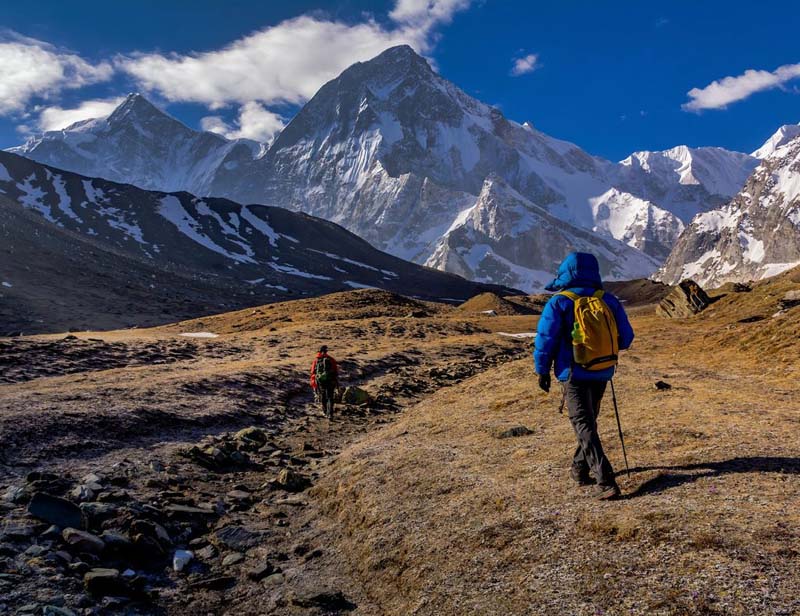Image Credit: pixahive.com
Treking poles can make a huge difference to not only your performance but can aid in the prevention of fatigue and add extra safety to this demanding, high-altitude trek when used properly. Trekking poles will be a must because the trail is going to be quite steep to go up and exposed to slippery paths to come down. The route has some tiny cliffside paths and slippery rocky paths. 30. Step one in placing the poles is to align them to the right top: whilst the recommendations touch the ground, your elbows ought to be at a ninety-degree angle. Shorten them a bit on the up to add a little more pushing power; lengthen for the descent to save your knees. Begin to swing the poles together to the beat of your walking cadence to make sure you are in the right position. To keep your balance and energy output, perform alternate pole and leg placement.
Why should I hike using trekking poles for the Manaslu Circuit?
BeTherere many reasons for taking trekking poles along the trail of Manaslu Base Camp Trek, such as the trail has lots of up and down ascents along with unpredictable trails. In fact, on the high-elevation trial, trekkers will see the cliffs, rivers, stones’ step, the ruins of stone’s stair, and the try to conquer the giant Larkya La Pass — all of these can can frequency to the poles use for distribution weight: long-day journeys, if heavy under the burden of your baggage, your knee can easily is aching. So for your safety, and for that of your joints, and to build up your tolerance, trekking poles are going to be extremely helpful; and after coming down, you can decrease up to 25% tension of your knees and legs while using it, so to the extent that roesn’t get fatigued. According to The poles also help make you steadier in rain, snow, or loose scree somewhere in the middle of the Himalayas, and can assist in crossing rivers or in testing how solid a trail is. Thus, it would probably be a better idea to cough up a few dollars and buy some trekking poles before giving a pair to a non-functional human being. They will help you to use trekking poles on trekking poles’ legs properly, more cconvenientlyststeadilynd muscle and muscle-injury-preserving.
On What Type of Terrain are the Trekking Poles to be Adjusted?
Correctly adjusted, it will ensure that the features of trekking poles for multiple conditions while trekking Manaslu are used to the greatest effect. When held on flat terrain, the trekking poles are supposed to have a 90-degree angle at the elbow. Reducing the length of them by 5-10 cm may enable better pushing and a more upright posture when climbing and when thatching up. As you come down the poles, they should be slightly extended to accommodate shock and act as knee support. Additionally, he locking mechanism should be secured in position when the pole is set. And there are models that offer a quick adjustment to lengthen or shorten the poles on the fly. You might consider doing one pole at a time for tight or difficult areas. For snow or during the rainy season, modify the dimensions of the basket. Adapting the duration of the poles to the terrain you’re on will help you overcome fatigue, improve your stability, and aid the technical factors of trekking. Practice changes on the trail is why you want to do this before you are trekking.
How can we use trekking poles correctly?
The use of trekking poles the right way on the Manaslu Circuit virtually lets you hold a very good rhythm and balance. To do it, rely on your poles in a way that makes you feel energized and sturdy. One way is to contain them in the rhythm of your foot. You move forward as you stroll, your right foot moving forward. Then the second lunge, step the left forward to balance yourself using the left pole. Systematically do the same. Do not grip the pole handle hard: it’s better to use loopy wrist bands in order to hang off your arms. Let your impromptu wrist move as it wants to and turn to fight the force of push down nd try not to let your hand death grip the pole every time. The elbows should be drawn in close to the body so the muscles won’t tire. On the uphill, plant the poles directly in front of you to help you build momentum as you push yourself up the hill on each stroke. Clench your pole slightly out and down on your way down; this resistance will keep you from beating your knees up the hill. Don’t shuffle the pole, reach out too far with it; your stride should alternate with them. Be positive as you practice pole use for more effectiveness and efficiency, a nd use energy throughout a long day.
Why does using a trekking pole decrease the chance of being injured on the Manaslu Trek?
Trekking poles are important in minimizing the risk of injury on the steep, remote Manaslu Circuit.. The path is made of steep climbs and descents, rocky ground, river crossings, and tight-rope walking, nd finally slips, falls, nd fatigue. The poles enhance stability and help trekkers make immediate corrections to their balance as well as prevent twisted ankles and mishaps. They also lessen the impact on knees, hips, nd ankles, which is great for the long outward descent from Larkya La Pass. Poles distribute your weight between your arms and legs providing muscular stress that would be less, and the danger of overuse injury decreases. Poles are extra touch points, you don’t slip and wobble in slippery or loose sections. They may be additionally useful for detecting inclined grounds or snow bridges, specifically for older trekkers, or if you are carrying a heavy load, poles can assist in guarding your joints from pressure and slippage. In reality, whilst used nicely, trekking poles are important safety tools that offer confidence and stability in hard environments.
When to Use Wrist Straps – and Why it Matters
Lastly, properly using wrist straps will help when trekking with your trekking poles on the Manaslu Circuit. It’s not just that the straps keep your poles and hands from ending up on the ground — they can help you use as little grip strength as possible and maximize energy transfer. Wrist Straps Use wrist straps and slide your hand up through the strap and grip the pole handle so that the grip handle is enclosed by the strap, nd the strap encircles the pole and your hand. Your wrist takes the brunt of the force in your arm rather than your hand. These cut hand fatigue on marathon days. You can also press on the strap when climbing, forcing yourself up. Downhills, they give you a little extra help, because. Swinging the pole doesn’t provide added support. And also you get the stability needed on rough terrain without the tight grip needed all the titimeThey can, but should be removed in uber grippy sections or river crossings where a quick release might be needed. Well-dialed wrist straps will make you more comfortable, much less worn out, and your use of the pole will be extra seamless at some point of the trek.
Do Trekking Poles Aid in the Prevention of Altitude Sickness?
Trekking Pole, Myth and Reality. Although folklore says that trekking poles can help you avoid altitude sickness, they can’t. Sorry, but no magic hiking gear will make you feel better above 16,000 ft at Larkya La Pass. While that rumor is false, they may indeed be able to help you in ways that help offset some effects of extreme altitude. Poles can aid you in pacing yourself on a long ascent, which can in turn make an acclimatization-friendlier, slow ascent more achievable and keep with, minimizing the risk of AMS. Pole use for minor spasmodic freezing can be useful, as your balance is vision impaired, nd it can assist, although it is not a replacement for your brain. They would keep you straight in the spine to aid the ability of your lungs to take in oxygen, because your muscles would be more cushioned, or subjected to slumber and strain. Even though poles don’t assist you stave off altitude illness on their very personal, they’re a critical part of preserving the delicate stability between velocity and high-quality-pacing electricity consumption at this type of high altitude.
How do you select the best trekking poles for the Manaslu trek?
The primary class hiking poles for the Manaslu Trekking are probably a balance between weight, sturdiness, and adjustability. Select poles from light-weight aluminum, or carbon fiber – aluminum is strong and less expensive, whilst carbon fiber is lighter, but also more likely to snap.


